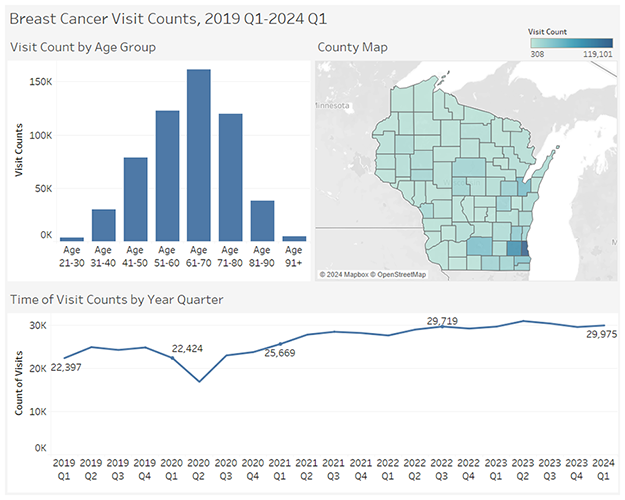Click here to view past issues
IN THIS ISSUE
EDUCATION EVENTS
Aug. 8, 2025
WHA Financial WorkshopSep. 17, 2025
2025 Annual Wisconsin Organization of Nurse Leaders ConferenceJan. 28, 2026
2026 WHA Health Care Leadership AcademyClick here to view education event calendar
View more issues of The Valued Voice
Sign Up for WHA's Newsletter
Fast Facts from the WHA Information Center: October is Breast Cancer Awareness Month
According to the National Breast Cancer Foundation, in 2024 there will be an estimated 310,800 new invasive breast cancer diagnoses in the United States. One in eight women will be diagnosed with breast cancer in her lifetime. Outside of skin cancer, breast cancer is the most diagnosed form of cancer in women. It also is the second leading cause of cancer death in women. According to the National Cancer Institute, the rate of invasive breast cancer (per 100,000 women) in Wisconsin is 133 cases. There are roughly 3.8 million breast cancer survivors living in the United States. And while it is rare, men are also diagnosed with breast cancer. In 2024, it is estimated that almost 2,800 men in the United States will be diagnosed with breast cancer. October is known as Breast Cancer Awareness Month to increase education and raise funds for research. The WHA Information Center analyzed data from early 2018 to early 2024 for breast cancer visits. The place of service with the highest visits count is lab services followed by other outpatient visits. In the timeline chart, there is a definite drop during when stay at home orders were in place for COVID-19. The average age of a patient is 62 years old. While most patients seen for breast cancer are female, there is about one percent of claims that are for male patients. Most patient visits were seen in outpatient lab and radiology (OLR) visits followed by other outpatient services.
The WHA Information Center analyzed data from early 2018 to early 2024 for breast cancer visits. The place of service with the highest visits count is lab services followed by other outpatient visits. In the timeline chart, there is a definite drop during when stay at home orders were in place for COVID-19. The average age of a patient is 62 years old. While most patients seen for breast cancer are female, there is about one percent of claims that are for male patients. Most patient visits were seen in outpatient lab and radiology (OLR) visits followed by other outpatient services.
Below are some common myths about breast cancer from the National Breast Cancer Foundation:
Myth: Finding a lump in your breast means that you have breast cancer.
Truth: Only a small percentage of breast lumps turn out to be cancer. But if you discover a persistent lump in your breast that is new or notice any changes in breast tissue, it should never be ignored.
Myth: A mammogram can cause breast cancer to spread.
Truth: A mammogram, or x-ray of the breast, currently remains the gold standard for the early detection of breast cancer. Breast compression while getting a mammogram cannot cause cancer to spread. The standard recommendation is an annual mammographic screening for women beginning at age 40.
Myth: If you have a family history of breast cancer, you are likely to develop breast cancer, too.
Truth: While women who have a family history of breast cancer are in a higher risk group, most women who have breast cancer have no family history. Statistically, only about 10% of individuals diagnosed with breast cancer have a family history of this disease. If you have a mother, daughter or sister who developed breast cancer under the age of 50, you should consider some form of breast imaging starting 10 years before the age of your relative’s diagnosis. If you have had a grandmother or aunt who was diagnosed with breast cancer, your risk increases slightly, but it is not in the same risk category as those who have a first degree relative with breast cancer.
Fast Facts from the WHA Information Center: October is Breast Cancer Awareness Month
According to the National Breast Cancer Foundation, in 2024 there will be an estimated 310,800 new invasive breast cancer diagnoses in the United States. One in eight women will be diagnosed with breast cancer in her lifetime. Outside of skin cancer, breast cancer is the most diagnosed form of cancer in women. It also is the second leading cause of cancer death in women. According to the National Cancer Institute, the rate of invasive breast cancer (per 100,000 women) in Wisconsin is 133 cases. There are roughly 3.8 million breast cancer survivors living in the United States. And while it is rare, men are also diagnosed with breast cancer. In 2024, it is estimated that almost 2,800 men in the United States will be diagnosed with breast cancer. October is known as Breast Cancer Awareness Month to increase education and raise funds for research. The WHA Information Center analyzed data from early 2018 to early 2024 for breast cancer visits. The place of service with the highest visits count is lab services followed by other outpatient visits. In the timeline chart, there is a definite drop during when stay at home orders were in place for COVID-19. The average age of a patient is 62 years old. While most patients seen for breast cancer are female, there is about one percent of claims that are for male patients. Most patient visits were seen in outpatient lab and radiology (OLR) visits followed by other outpatient services.
The WHA Information Center analyzed data from early 2018 to early 2024 for breast cancer visits. The place of service with the highest visits count is lab services followed by other outpatient visits. In the timeline chart, there is a definite drop during when stay at home orders were in place for COVID-19. The average age of a patient is 62 years old. While most patients seen for breast cancer are female, there is about one percent of claims that are for male patients. Most patient visits were seen in outpatient lab and radiology (OLR) visits followed by other outpatient services.
Below are some common myths about breast cancer from the National Breast Cancer Foundation:
Myth: Finding a lump in your breast means that you have breast cancer.
Truth: Only a small percentage of breast lumps turn out to be cancer. But if you discover a persistent lump in your breast that is new or notice any changes in breast tissue, it should never be ignored.
Myth: A mammogram can cause breast cancer to spread.
Truth: A mammogram, or x-ray of the breast, currently remains the gold standard for the early detection of breast cancer. Breast compression while getting a mammogram cannot cause cancer to spread. The standard recommendation is an annual mammographic screening for women beginning at age 40.
Myth: If you have a family history of breast cancer, you are likely to develop breast cancer, too.
Truth: While women who have a family history of breast cancer are in a higher risk group, most women who have breast cancer have no family history. Statistically, only about 10% of individuals diagnosed with breast cancer have a family history of this disease. If you have a mother, daughter or sister who developed breast cancer under the age of 50, you should consider some form of breast imaging starting 10 years before the age of your relative’s diagnosis. If you have had a grandmother or aunt who was diagnosed with breast cancer, your risk increases slightly, but it is not in the same risk category as those who have a first degree relative with breast cancer.

